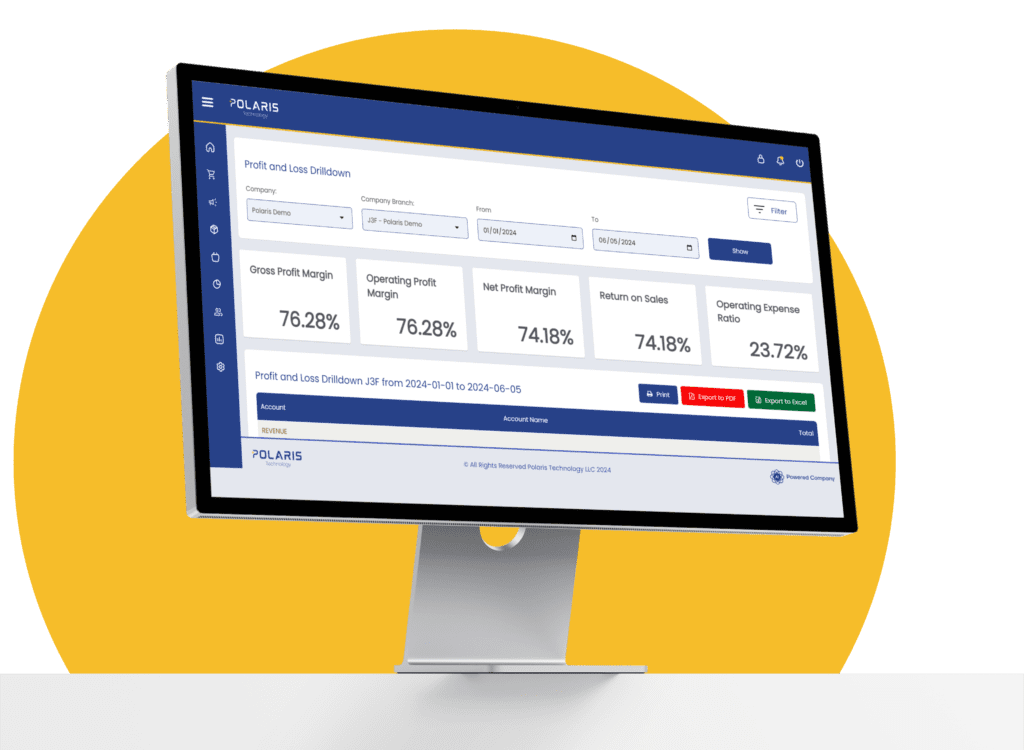
AI-Powered Food Cost Calculator
Cost Discipline Profitability Boost Consistent Quality
Food costs, or the cost of goods sold (COGS), represent the total expense incurred in preparing and selling a menu item. This includes the cost of all ingredients, such as meats, vegetables, spices, and any other components used in the dish. Additionally, it accounts for the portion sizes and waste generated during preparation.
How Does the Food Cost Calculator Work?
In our system, the food cost calculator is an advanced tool, where you don’t have to manually input ingredients, quantities or units of measure to understand the food cost. Because Polaris ERP includes purchase, inventory, recipe management, or accounting, all elements are predefined, as part of the recipe management. So, you will see all ingredients for each dish in one dashboard.
To get information about each item, all you need to do is to select the ingredient, and the system will display the quantity used, as well as the unit of measure. In case you will need to edit the recipe and add new items this is also possible, by simply clicking the “Add New” button.
Next, to understand how you can keep your profit to a specific percentage that you desire, or increase the profit of a specific menu item, we have integrated AI technology that looks into all your individual systems (like inventory, purchase, sales, accounting, etc.). It centralizes all data to give you real insights and recommendations on what you can actually do to reach your goals.
Instead of entering all your food costs for this specific menu item manually into a classical food cost calculator, and then letting the system tell you what the selling price should be, with Polaris ERP we apply a different philosophy. The goal is to keep consistent quality for the dish, and to apply a percentage increase only if the menu item allows this strategy, meaning that if clients are willing to accept the percentage increase you want to apply. In this sense, the system promotes a cost discipline, providing you with a fully integrated analysis and strategy to optimize costs, without compromising the quality of the dish, looking into ingredient optimization, waste management opportunities, etc.
Client Results
Reduction in Food Wastage
Using recipe management and precise cost of goods sold (COGS) for a local burger restaurant. they were able to bring food wastage down to 20% per year.
Menu Profit Optimization
The accurate food and recipe costing enables informed profitability analysis, with data-driven pricing adjustments to optimize menu profits and adapt to market trends.
Increase in Profitability
With the recipe management functionality of Polaris ERP, our client can calculate the precise cost of each menu item, including ingredients, labor, and overhead expenses.
Benefits of AI-Powered Food Cost Calculator
Cost Discipline
It provides detailed insights into where your money is going, allowing you to identify areas where you can cut costs (i.e. ordering fewer items), without compromising on quality.
Consistent Quality
By standardizing recipes and portion sizes, a food cost calculator ensures that each dish is prepared consistently, maintaining quality and customer satisfaction.
Higher Profitability
With the AI-embedded technology, you can receive precise insights on how much to increase the price of each dish to achieve your desired profitability.
Problems AI-Powered Food Cost Calculator Solves
Profit Leakage
It identifies hidden costs and inefficiencies, helping restaurant owners to adjust prices or reduce expenses to prevent profit leakage and improve overall financial health.
Overstocking
It aids in accurate inventory management, preventing overstocking by ensuring you purchase only what you need, reducing excess inventory and associated costs.
Spoilage
By tracking inventory levels and ingredient usage, it helps reduce spoilage and waste, ensuring that ingredients are used efficiently and not left to expire.
Restaurant Food Cost Calculator FAQ
The ideal food cost in the restaurant environment typically ranges between 25% and 35% of a dish’s selling price. This percentage ensures that the restaurant can cover its more than the costs of ingredients and other food items, including labor, rent, utilities, and other overheads, while still achieving a profitable margin. The exact ideal percentage can vary depending on the type of restaurant, cuisine, and location.
A food cost calculator helps maintain consistent quality in dishes by standardizing recipes and portion sizes. By precisely calculating the cost and amount of each ingredient needed for a dish, it ensures that the same ingredients are used in the same quantities every time the dish is prepared, reducing variability, enhancing customer satisfaction and maintaining quality.
A food calculator removes inaccurate pricing by providing precise cost data for each ingredient used in a dish. This allows restaurant owners to accurately calculate the total cost of preparing each menu item, ensuring that prices are set to cover costs and achieve desired profit margins, eliminating guesswork and reducing the risk of underpricing or overpricing.
Yes, a food cost calculator can help identify and eliminate non-movable items from the menu. By tracking the cost, sales, and profitability of each dish, it provides insights into which items are not selling well or are not profitable. This allows restaurant owners to make informed decisions about which dishes to remove, adjust, or promote, optimizing the menu for better performance and profitability.
